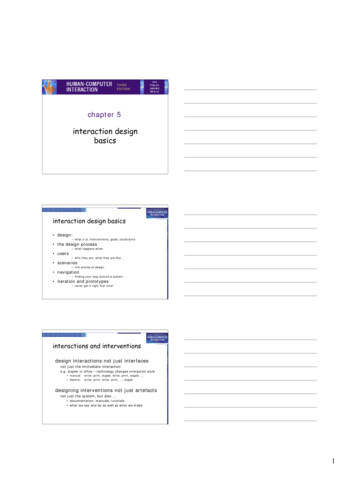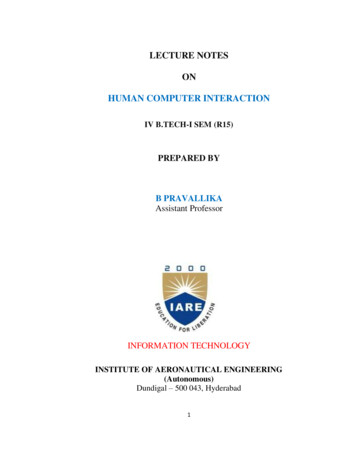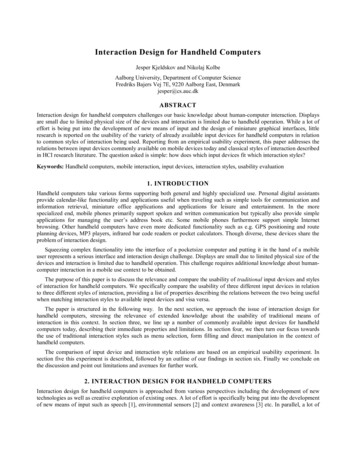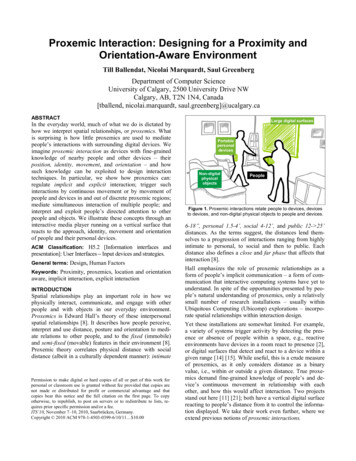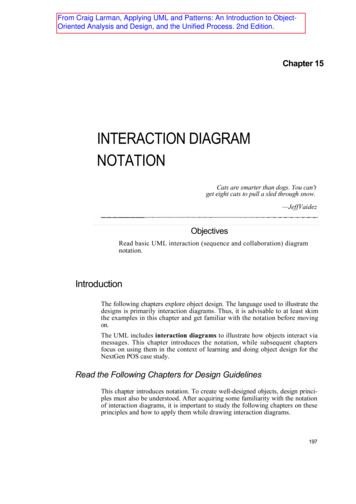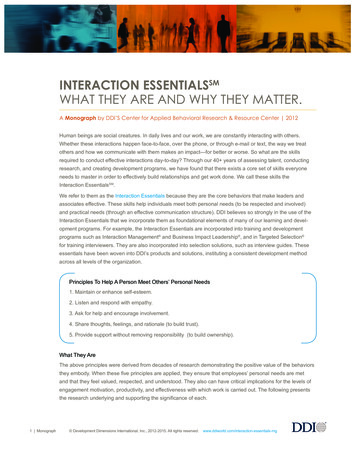
Transcription
INTERACTION ESSENTIALSSMWHAT THEY ARE AND WHY THEY MATTER.A Monograph by DDI’S Center for Applied Behavioral Research & Resource Center 2012Human beings are social creatures. In daily lives and our work, we are constantly interacting with others.Whether these interactions happen face-to-face, over the phone, or through e-mail or text, the way we treatothers and how we communicate with them makes an impact—for better or worse. So what are the skillsrequired to conduct effective interactions day-to-day? Through our 40 years of assessing talent, conductingresearch, and creating development programs, we have found that there exists a core set of skills everyoneneeds to master in order to effectively build relationships and get work done. We call these skills theInteraction EssentialsSM.We refer to them as the Interaction Essentials because they are the core behaviors that make leaders andassociates effective. These skills help individuals meet both personal needs (to be respected and involved)and practical needs (through an effective communication structure). DDI believes so strongly in the use of theInteraction Essentials that we incorporate them as foundational elements of many of our learning and development programs. For example, the Interaction Essentials are incorporated into training and developmentprograms such as Interaction Management and Business Impact Leadership , and in Targeted Selection for training interviewers. They are also incorporated into selection solutions, such as interview guides. Theseessentials have been woven into DDI’s products and solutions, instituting a consistent development methodacross all levels of the organization.Principles To Help A Person Meet Others’ Personal Needs1. Maintain or enhance self-esteem.2. Listen and respond with empathy.3. Ask for help and encourage involvement.4. Share thoughts, feelings, and rationale (to build trust).5. Provide support without removing responsibility (to build ownership).What They AreThe above principles were derived from decades of research demonstrating the positive value of the behaviorsthey embody. When these five principles are applied, they ensure that employees’ personal needs are metand that they feel valued, respected, and understood. They also can have critical implications for the levels ofengagement motivation, productivity, and effectiveness with which work is carried out. The following presentsthe research underlying and supporting the significance of each.1 Monograph Development Dimensions International, Inc., 2012-2015. All rights g
Maintain or Enhance Self-EsteemSelf-esteem refers to one’s self-evaluation, or appraisal of one’s own worth. It is the second highest needon Maslow’s hierarchy. And it can be impacted by all interactions with others. The concept of self-esteemrose to popularity in the late 1960s, pioneered by psychotherapist Nathaniel Branden and psychologist StanleyCoopersmith (who defined self-esteem as an attitude and expression of worthiness). To date, approximately536 studies, 769 articles, and 80 books have been written on the impact of self-esteem on work performance.Some of the reported outcomes of high self-esteem include high levels of career and job satisfaction, improvedmotivation and engagement, high-quality work, better personal and professional relationships, and more innovation at work. Individuals who maintain or enhance others’ self-esteem tend to be seen as highly effective andenjoy better team communication and less tension in the workplace. They also are likely to lead employeeswith higher job satisfaction and performance, greater loyalty, and interpersonal trust.ReferencesBowling, N.A., Eschleman, K.J., Qiang, W., Kirkendall, C., & Alarcon, G. (2010). A meta-analysis of the predictors and consequences of organization-based self-esteem. Journal of Occupational & Organizational Psychology, 83(3), 601–626.Brockner, J. (1988). Self-esteem at work: Research, theory, and practice. Lexington, MA: Lexington Books.Ferris, D.L., Lian, H., Brown, D.J., Pang, F.X.J., & Keeping, L.M. (2010). Self-esteem and job performance: The moderating role ofself-esteem contingencies. Personnel Psychology, 63(3), 561–593.Fisher, B.M., & Edwards, J.E. (1988). Consideration and initiating structure and their relationships with leader effectiveness: A meta-analysis. BestPapers Proceedings, Academy of Management, Anaheim, CA, 201–205.Garske, G.G. (1996). The relationship of self-esteem to levels of job satisfaction of vocational rehabilitation professionals. Journal of Applied Rehabilitation Counseling, 27(2), 19–22.Grimm-Thomas, K., & Perry-Jenkins, M. (1994). All in a day’s work: Job experiences, self-esteem, and fathering in working-class families. FamilyRelations, 43(2), 174–181.Lopez, E. (1982). A test of the self-consistency theory of the job performance–job satisfaction relationship. Academy of ManagementJournal, 25(2), 335–348.Lucas, M.S., & Epperson, D.L. (1990). Types of vocational undecidedness: A replication and refinement. Journal of Counseling Psychology, 37(4),382–388.Listen and Respond with EmpathyThe ability to empathize is an important skill to possess. The modern understanding of empathy—meaning “theidentification with or vicarious experiencing of the feelings, thoughts, or attitudes of another”—was first usedin the works of sociologist Max Weber and psychologist Wilhelm Dilthey. Empathetic people are more willingto use their time and resources to help people, to enable others to maintain a sense of competence and selfworth, and to avoid behaviors that would betray others’ trust.Within the last 10 years, approximately 550 articles and over 160 books have been written on using empathy ininterpersonal interactions. Leaders who demonstrate empathy with their employees are perceived to be bettercoaches, while employees who believe their leaders are empathetic tend to be more engaged in their work andless fatigued, depressed, and anxious.ReferencesAnderson, S.E., & Williams, L.J. (1996). Interpersonal, job, and individual factors related to helping processes at work. Journal of Applied Psychology,81(3), 282–296.Goleman, D., Boyatzis, R.E., & McKee, A. (2004). Primal leadership: Learning to lead with emotional intelligence. Boston: Harvard Business Press.Ikemi, A., & Kubota, S. (1996). Humanistic psychology in Japanese corporations: Listening and the small steps of change. Journal ofHumanistic Psychology, 36(1), 104–121.Kellett, J.B., Humphrey, R.H., & Sleeth, R.G. (2006). Empathy and the emergence of task and relations leaders. The Leadership Quarterly, 17(2),146–162.Krivonos, P.D. (1978). The relationship of intrinsic-extrinsic motivation and communication climate in organizations. Journal of Business Communication, 15(4), 53–65.McBane, D.A. (1995). Empathy and the salesperson: A multidimensional perspective. Psychology & Marketing, 12(4), 349–370.Patnaik, D. (2009). Wired to care: How companies prosper when they create widespread empathy. Upper Saddle River, NJ: FT Press.Stowell, S.J. (1988). Coaching: A commitment to leadership. Training and Development Journal, 42(6), 34–38.2 Monograph Development Dimensions International, Inc., 2012-2015. All rights g
Ask for Help and Encourage InvolvementIndividuals want to feel involved, to feel as though their opinions and thoughts matter. At work this translatesinto leaders and team members reaching out to one another for support. A high-involvement work environmentbegan as a trend in the 1970s, but has since become the norm in highly effective organizations. In the last 10years, over 915 articles and 19 books have been written on high-involvement work environments.Leaders are seen as more effective when they create a participative work environment. Employees in such ahigh-involvement work environment perceive that they have more variety, autonomy, and impact along with agreater level of influence in their jobs. They also report a higher degree of job satisfaction, more trust in management, and increased self-confidence.ReferencesBenson, G.S., Young, S.M., & Lawler, E.E., III. (2006). High-involvement work practices and analysts’ forecasts of corporate earnings.Human Resource Management, 45(4), 519–537.Crouter, A.C. (1984). Participative work as an influence on human development. Journal of Applied Developmental Psychology, 5, 71–90.Konrad, A.M. (2006). Engaging employees through high-involvement work practices. Ivey Business Journal, 70(4), 1–6.Ledford, G.E., Jr., & Mohrman, S.A. (1993). Self-design for high-involvement: A large-scale organizational change. Human Relations, 46(2), 143–173.Mendelson, M.B., Turner, N., & Barling, J. (2011). Perceptions of the presence and effectiveness of high involvement work systems and their relationship to employee attitudes: A test of competing models. Personnel Review, 40(1), 45–69.Mohr, R.D., & Zoghi, C. (2008). High-involvement work design and job satisfaction. Industrial & Labor Relations Review, 61(3), 275–296.Stowell, S.J. (1988). Coaching: A commitment to leadership. Training and Development Journal, 42(6), 34–38.Share Thoughts, Feelings, and Rationale (to build trust)In the workplace, sharing thoughts, feelings, and the rationale behind decisions builds a more trusting environment. When leaders and team members open up, they encourage others (direct report, colleagues) to do thesame. This open communication also fosters a positive team dynamic, making everyone more productive.The concept behind this principle was pioneered in the 1970s by sales and marketing expert Neil Rackhamin his pivotal research study on sales effectiveness in major multinational companies. Rackham’s researchfocused on the impact of interaction skills training and the importance of motivation and emotions during workinteractions. He demonstrated that, to build trust, leaders need to disclose their own thoughts and feelings.According to his research, trust in leadership is a critical requirement for employees to have, and their degreeof trust affects overall organizational and work group effectiveness, employee satisfaction with leadership, andthe overall level of innovation.In the last 10 years, more than 100,000 articles and studies and 4,780 books have been written on buildingtrust in the workplace.ReferencesDenton, D.K. (2009). Creating trust. Organization Development Journal, 27(4), 11–20.Dirks, K.T., & Ferrin, D.L. (2002). Trust in leadership: Meta-analytic findings and implications for research and practice. Journal of Applied Psychology,87, 611–628.Driscoll, J.W. (1978). Trust and participation in organizational decision making as predictors of satisfaction. Academy of ManagementJournal, 21(1), 44–56.Elfenbein, H.A., & Ambady, N. (2002). Predicting workplace outcomes from the ability to eavesdrop on feelings. Journal of Applied Psychology, 87(5),963–971.Galford, R., & Drapeau, A.S. (2002). The trusted leader: Bringing out the best in your people & your company. New York: The Free Press.Kouzes, J.M., & Posner, B.Z. (2007). The leadership challenge (4th ed.). San Francisco: Jossey-Bass.Lyman, A. (2003). Building trust in the workplace: Why trust brings out the best in your employees. Strategic HR Review, 3(1), 24–27.Rackham, N., Honey, P., & Colbert, M. (Eds.). (1971). Developing interactive skills. London: Wellens.Schmidt, W.H., & Posner, B.Z. (1982). Managerial values and expectations: The silent power in personal and organizational life. New York: AMA. Trustin the workplace: 2010 ethics & workplace survey. (2010). New York: Deloitte.3 Monograph Development Dimensions International, Inc., 2012-2015. All rights g
Provide Support without Removing Responsibility (to build ownership)Providing support is a critical role of a manager or team member. The interconnectedness of today’s workplacemeans it is difficult to do a job without anyone’s help. However, when seeking help, it is important for the supportto come without removing the ownership of the task. This is how individuals learn, grow and develop in theirroles. The ability to provide support without removing responsibility is the driving force behind this senseof empowerment.In the last 10 years, approximately 7,000 articles and 1,500 books have been written on empowerment in the workforce. This body of research demonstrates multiple individual and organizational benefits of empowering and encouraging employees to psychologically own their jobs. Managers are seen as more effective when they performsupportive behaviors without taking over, delegate decision making, provide a culture of continuous improvement,and balance trust and feedback. They must also coach their team members to help them be more successful,without telling them what to do or removing their ownership or responsibility. Organizational benefits of increasedempowerment include improved productivity, product quality, customer service, employee satisfaction, and teamperformance; gains in market share and customer satisfaction; and a reduction in production costs.ReferencesAvolio, B.J., Zhu, W., Koh, W., & Bhatia, P. (2004). Transformational leadership and organizational commitment: Mediating role of psychologicalempowerment and moderating role of structural distance. Journal of Organizational Behavior, 25, 951–968.Byham, W. C., Cox, J. (1997). Zapp! The Lightning of Empowerment: How to Improve Productivity, Quality, and Employee Satisfaction. BallantineBooks.Deal, T.E., & Jenkins, W.A. (1994). Managing the hidden organization: Strategies for empowering your behind-the-scenes employees. New York: Warner.Fuller, J.B., Morrison, R., Jones, L., Bridger, D., & Brown, V. (1999). The effects of psychological empowerment on transformational leadership and jobsatisfaction. Journal of Social Psychology, 139(3), 389–391.Gibson, C.B., Porath, C.L., Benson, G.S., & Lawler, E.E., III. (2007). What results when firms implement practices: The differential relationship betweenspecific practices, firm financial performance, customer service, and quality. Journal of Applied Psychology, 92(6), 1467–1480.Ginnodo, B. (Ed.). (1997). The power of empowerment: What the experts say and 16 actionable case studies. Arlington Heights, IL: Pride.Lawler, E.E., III, Mohrman, S.A., & Ledford, G.E., Jr. (1995). Creating high performance organizations: Practices and results of employee involvementand total quality management in Fortune 1000 companies. San Francisco: Jossey-Bass.Spreitzer, G. (2007). Taking stock: A review of more than twenty years of research on empowerment at work. In C.L. Cooper & J. Barling (Eds.), TheSAGE handbook of organizational behavior, Vol. 1: Micro approaches (pp. 54–72). New York: Sage.Wellins, R. S., et alia. (1991). Empowered Teams: Creating Self-Directed Work Groups That Improve Quality, Productivity, and Participation. Jossey-Bass.Yukl, G.A., & Becker, W.S. (2006). Effective empowerment in organizations. Organization Management Journal, 3(3), 210–231.Guidelines for How to Meet People’s Practical Needs (Task Skills)What They AreIn addition to ensuring that personal needs are met, DDI developed guidelines over 40 years ago to providestructure and best practices for effective interactions to meet practical needs. In day-to-day interactions withcoworkers, these guidelines help provide structure to maximize the effectiveness of those conversations toinfluence others, solve a problem or make better decisions. These guidelines (Open, Clarify, Develop, Agree,and Close) focus on the practical side of interactions because relying solely on personal needs without meetingpeople’s practical needs will still result in an ineffective interaction. By using these guidelines, leaders and teammembers can get work done through others more effectively and efficiently. In addition to the five guidelines, thereare additional skills needed to ensure that each person understands what has been discussed and to keep thediscussion moving forward. These process skills are: check for understanding and make procedural suggestions.4 Monograph Development Dimensions International, Inc., 2012-2015. All rights g
In today’s hectic, performance-oriented workplace, the time spent interacting with others must be productive.Whether interacting with an individual or a group, in a formal or a spontaneous discussion, in person or over thephone, every interaction must accomplish its purpose efficiently. Each guideline represents an important, logicalstep in the discussion process. Together they provide a road map to guide effective discussions. When theseguidelines are applied with the aforementioned skills (empathy, maintaining self-esteem, etc.), they ensure thatemployees’ personal AND practical needs are met, and ultimately better, and more effective interactions.The content of DDI’s model is based on real behaviors exhibited in hundreds of thousands of interactions observed in assessment and training settings. This distinctive model provides a process that can be easily adapted to either personal or professional situations. The process can be used to resolve conflicts, discuss a majorchange, set expectations, delegate an important responsibility, or conduct any discussion in which you need toclarify the situation, develop ideas, and agree on actions.Interaction Essentials ProcessOPEN At the start of an interaction, let people know whatyou want to talk about and why it’s important. If you begin the discussion, explain its purposeand importance. If another person begins the discussion, and doesn’texplain the purpose and importance, you can:–– Ask what they want to talk about and why.–– State your understanding and ask if it’s correct. Where appropriate, use idea generation andevaluation techniques. Help people identify any help, support, or resourcesthat might be needed.AGREE Once you have a list of good ideas and alternatives,involve everyone in choosing the ideas to put into action. Specify what will be done, who will do it, and by when.CLARIFY Before you begin discussing ideas or solutions,make sure everyone understands the details. Clarify facts, figures, or information that everyoneinvolved in the discussion needs to know tomove forward.DEVELOP Cultivate ideas to achieve the main goal. Actively seek involvement from all participants.5 Monograph Share your own ideas—after listening toeveryone else’s. Return to the CLARIFY step if you have another issueto talk about or proceed to the CLOSE step if there areno more issues. Repeat this process for each issue.CLOSE To make sure everyone understands what’s happening,go over the main points of the discussion and whatpeople agreed to. Make a final check on everyone’s confidence in theirability to follow up on the actions they agreed to. Development Dimensions International, Inc., 2012-2015. All rights g
Process Skill:Check for UnderstandingThis is a way to confirm that everyone has the same understanding of what has been discussed during thesession. The most effective way to check for understanding is to summarize the information in the form of aquestion and then request confirmation or correction. For example one might say “so what I heard you say is(fill in example), is this correct?”Process Skill:Make Procedural SuggestionsAn effective interaction needs a way to keep the discussion process on track, by identifying problems in theprocess itself and resolving them quickly. A good example of using this technique is: “We seem to have severalalternatives available. Let’s narrow our options down to two.” This action is about ensuring that goals in theinteraction are achieved in a timely manner.ReferencesAshkenas, R. (2010). Why We Secretly Love Meetings: The Status and Social Drive Beyond the Agenda. Harvard Business Review Online availableonline at blogs.hbr.org/ashkenas.Bang, H., Fuglesang, S.L., Ovesen, M.R., & Eilertsen, D.E. (2010). Effectiveness in top management group meetings: The role of goal clarity, focusedcommunication, and learning behavior. Scandinavian Journal of Psychology, 51(3), 253-261.Barry, B. & Crant, J.M. (2000). Dyadic Communication Relationships in Organizations: An Attribution/ Expectancy Approach. Organization Science,11(6), 648-664.Harvard Business Review on Effective Communication (1999). Boston, MA: Harvard Business School Publishing.Jay, A. (1976). How to Run a Meeting. Harvard Business Review, 54(2), 43-57.Mosvick, R.K. & Nelson, R.B. (1996). We’ve got to start meeting like this! Indianapolis: Park Avenue Productions.Myrsiades, L. (2000). Meeting sabotage: Met and conquered. Journal of Management Development, 19(10), 870–885.Nixon, C.T. & Littlepage, G.E. (1992). Impact of meeting procedures on meeting effectiveness. Journal of Business and Psychology, 6(3), 361–369.Tobia, P.M. & Becker, M.C. (1990). Making the most of meeting time. Training and Development, 44(8), 34–38.Why Interaction Essentials MatterWhy are the Interaction Essentials so critical? Experience and research have shown that the reason mostleaders in business fail is not because of a lack of business knowledge or technical skill, but because of interpersonal and communication shortcomings. The most cited reason that people leave their jobs is their relationships with their managers. Even CEOs, in part, fail due to a lack of essential interaction skills (e.g., Paul Ely(HP), Carly Fiorina (HP), John Havens (Citigroup), Stan O’Neal (Merrill Lynch), Bob Nardelli (Home Depot), andAl Dunlap (Scott Paper)). Therefore, there exists a greater need to develop these essential interaction skills.According to DDI’s data, including detailed assessment information on over 4,000 leaders, Interaction Essentials are a clear area for development. This research demonstrates that the Interaction Essentials are morelikely to be rated a development need by a leader’s managers and peers, compared to any other leadershipskill such as coaching, decision-making, and driving change. Specifically, 44 percent of development needsreported by managers and peers are Interaction Essentials in DDI’s analysis of a cross-organizational databaseof 360-degree feedback research (2011).The good news is that DDI’s research also demonstrates that the Interaction Essentials can be trained orimproved. And improvements in the Interaction Essentials correlate with improvements in higher-order leadership skills; for example, influence, managing others’ performance, and resolving conflict. Data collected from2,637 leaders and 4,120 of their managers, colleagues, and direct reports demonstrate a 33 to 59 percentimprovement in the number of leaders frequently meeting others’ personal needs after leadership training(see Figure 1). Specifically, when it comes to the behaviors related to meeting personal needs discussed6 Monograph Development Dimensions International, Inc., 2012-2015. All rights g
earlier, only about 57 percent of leaders were doing that effectively before training. After training, that numberrose to 76 percent according to leaders’ managers, peers, and direct reports, and up to 89 percent according toleaders themselves—a significant improvement.Figure 1. Improvements in Meeting Personal Needs After TrainingBecause leaders who master the foundational interaction skills will be more skillful in navigating other leadershipbehaviors (e.g., coaching, managing performance, influencing others), it is no surprise that this type of traininghas a significant impact on other leadership behaviors and even organizational outcomes. In addition to improvements in communication, teamwork, efficiency, and quality of work, employees who rated engagement and productivity higher in their work groups were significantly more likely to have leaders who effectively met the personal needs of others. In other words, employee engagement and productivity were affected by the extent to whichleaders met the personal needs (see Figure 2 and 3) and the practical needs (see Figure 4 and 5) of others.Figure 2 shows that when employees reported reduced engagement in their work environment, only 54 percentof them also reported that their leaders were meeting their personal needs. In contrast to employees who reported improved engagement, an overwhelming 89 percent reported their personal needs being met by their leader.Figure 2. How Meeting Personal Needs is Related to Improved Engagement7 Monograph Development Dimensions International, Inc., 2012-2015. All rights g
Figure 3 shows a similar finding, such that for employees who reported reduced productivity in their workgroups, only 60 percent of them reported that their leaders were meeting their personal needs. In contrast toemployees that reported improved productivity, 86 percent of them reported their personal needs being met bytheir leader.Figure 3. How Meeting Personal Needs is Related to Improved ProductivityFigure 4 demonstrates the same trend for meeting practical needs. Specifically, when employees reported aleaders’ ability to create and maintain a supportive work environment as low, only 2 percent of them reportedthat their leaders were effectively meeting their practical needs. In contrast to employees who reported theirleaders’ ability to maintain a supportive work environment as high, 87 percent of them reported their practicalneeds were being met by their leader.Figure 4. How Meeting Practical Needs is Related to Related to Improved Engagement8 Monograph Development Dimensions International, Inc., 2012-2015. All rights g
Figure 5 displays the finding that when employees reported a specific leaders’ ability to lead teams towardsmeeting productivity goals as low, only 2 percent of them reported that their leaders were effectively meetingtheir practical needs. In contrast to employees that reported their leaders’ ability to lead teams towards meetingproductivity goals as high, 83 percent of them reported their practical needs were being met by their leader.Figure 5. How Meeting Practical Needs is Related to Improved ProductivityIn summary, research supporting both the theory behind and the practice of using the Interaction Essentialsis abundant and persuasive, and that is the reason that they are at the core of many of DDI’s programs andsolutions. Because the Interaction Essentials are the foundation upon which all effective interactions are based,they are critical skills for everyone to have in order to foster supportive and productive relationships. They areof particular importance to leaders because research demonstrates that without the fundamental interactionskills, leaders will not be equipped to handle their responsibilities of keeping their employees engaged,satisfied, motivated, and, of course, productive. LEARN MOREInteraction EssentialsSM CONTACT USWorld Headquarters: 1 412.257.0600 info@ddiworld.comMKTLDMN01-0915 Development Dimensions International, Inc., 2012-2015. All rights g
Interaction EssentialsSM. We refer to them as the Interaction Essentials because they are the core behaviors that make leaders and associates effective. These skills help individuals meet both personal needs (to be respected and involved) and practical needs (through an effective communicati

